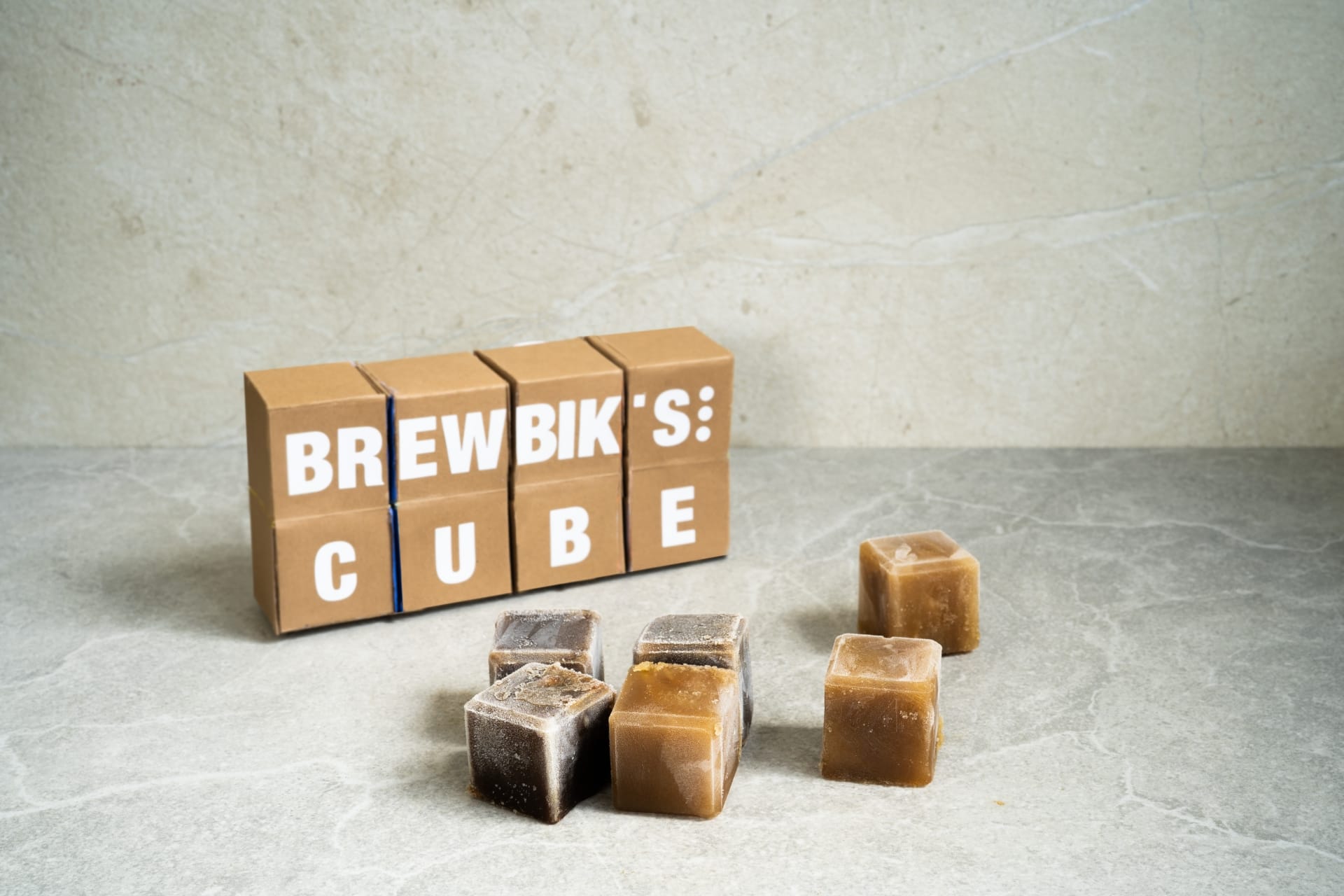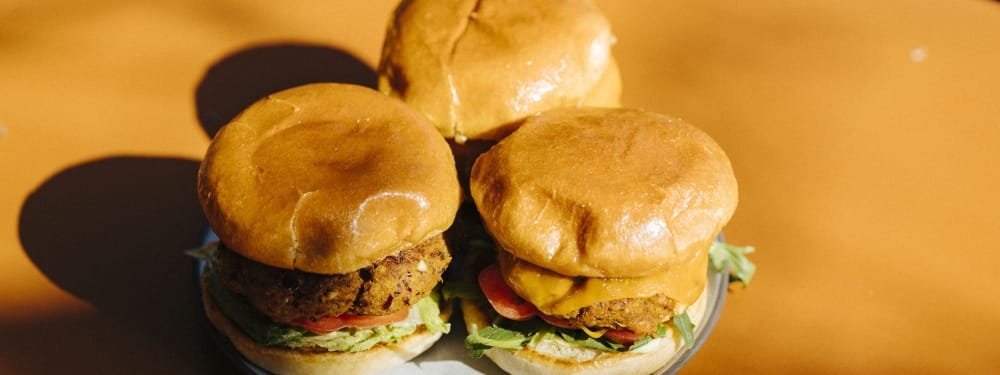Brewbik’s Cube – Zero Waste, Full Magic.
The German term Reste is derived from the Latin term restare. That means as much as – of course – remain. But what can you actually do with what’s left over? The MILK. Innovation Lab team addressed this question and invented a new frozen convenience product along the way.

According to the Federal Ministry of Food and Economic Affairs, the amount of food waste in Germany in 2020 was around 11 million tons. In social discourse, supermarkets are usually pilloried for this, but the BMEW figures speak a different language. 59% of food waste is produced in private households – that’s a whole 78kg per capita!
If we were to reduce 50% of household waste, we could save 6 million tons ofCO2. As foodies, the topic of zero waste has of course been on our minds for some time, as our Funky Falafel and Pulp Fiction burger patties show. This time, we’re turning our attention to unwanted vegetable offcuts and also using leftovers in our packaging concept!
The product – challenging and surprising!
Our Creative Kitchen masters Steffi and Can started with the recipe for the cube. Three different varieties were created from classic vegetable slices, leftover corn and an Asian mix, which were filled into an ice cube mold and frozen. Thanks to Steffi’s roasting and reduction, the purely plant-based ingredients achieved surprisingly good results and also scored points for their aesthetics in preparation. A small downer – the sections alone were not enough. In combination with fresh vegetables, however, they create well-portioned, easy-to-use seasoning wonders with a convincing taste!
Our favorite in the evaluation is the classic vegetable stock cube Better Broth, which impresses with its depth and complexity. You can clearly taste the intensified roasted aromas that are the result of production in the oven. The taste is hearty, spicy and full-bodied. Thickening with agar-agar and balancing with salt creates a strong, slightly thick vegan demi-glace. However, we were particularly surprised by the taste of the magic corn broth made from fresh cobs. While the vegetable stock cube was being made in the oven, the corn stock was simmering in a very large pot on the stove. The result is a very sweet, full-bodied and rich broth that offers a completely new taste experience.
Unfortunately, our Asian version failed, which is why it didn’t make it into the recipe details at the end of this article. Too spicy, too tart, too racy, too bitter. The mixture lacked the umami note of mushrooms, for example, which would not fit in with the zero-waste concept here. Even seasoning with shiro miso paste could not save the Far Eastern experiment. Too bad, Abrakad Asia!
Conclusion on the product
The initial taste test to create a full-bodied taste with just the peel of the classic vegetable stock was too flat. Using a peeler at home makes the peel very thin, the “leftover vegetables” are not enough. At an industrial level, on the other hand, peeling is done less sparingly, which means that such sections should work better. At home, you have to collect large quantities of peelings or mix in some fresh vegetables – but you will be rewarded for doing so. Unlike conventional stock cubes, melting Brewbik’s Cubes produces a tasty ready-made sauce that can also be enjoyed on its own.
The Packaging Concept – A Full Circle Moment
The idea of our cubes is to add a little bit of magic to every dish. And what is more synonymous with magic in everyday life than the legendary Rubik’s Cube! But it’s not just solving one that’s complex, it’s also building one. Unfortunately too complex for a functioning packaging solution. But the world of magic cubes has much more to offer than we muggles can imagine…
An Infinity Cube is quick to build, brings a smile to everyone’s face and has space for 8 cubes of 3x3cm each. The individual cubes can be separated by perforation without impairing the product protection of the others. The only drawback: for a scalable version, the design would also have to be significantly simplified to prevent overly complex production steps and excessive use of materials.
Speaking of materials: here too, we are staying true to the zero-waste idea and are testing a barrier paper made from agricultural waste for our concept, provided by one.fivean up-and-coming start-up from Holm near Hamburg. One.five is working on a whole range of sustainable material solutions, which can also be seen in our Material Lab. Their solution for frozen products is the Hazelsun barrier paper.
The base paper is made from leaves and stalks left over from the production of rice, grain or corn. This use of secondary raw materials makes the paper stand out in the life cycle assessment, especially in comparison to conventional wood fiber paper. One.five coats the food-safe material with a bio-based coating to ensure product protection. Thanks to the low use of this coating, the final material is compatible with conventional paper recycling and can be disposed of in waste paper. A market-ready, scalable solution with great potential for the food market.

Conclusion on the packaging concept
A concept that is undoubtedly fun and stands out at the point of sale. Once you’ve held the Brewbik’s Cube in your hand, you won’t forget it in a hurry. Paper-based materials could be used to improve some plastic solutions with improved barriers and could play an increasingly important role in the deep-freeze sector in the future, also in view of the PPWR boost. As always in the packaging sector, however, there are no one-size-fits-all solutions. For some frozen products, mono plastics will continue to offer the best and most sustainable product protection in the future, as the Frosta example from our Trend Radar shows. Only the test on the end consumer can provide certainty.
And so there are still some unanswered questions for our cubes, but, in the words of Erno Rubik:
“If you are curious, you’ll find the puzzles around you. If you are determined, you will solve them.”

Brewbik’s Cubes recipes
“Magic corn“
Preparation: In a saucepan
Makes 4800 ml reduced for 120 minutes = 1260 ml stock
Fresh sweetcorn
1264 g Corn cobs, cuttings, husks
2200 Corn kernels
Vegetable onions
100 g onion skins and trimmings
300 g vegetable onions
Carrots
200 g sections, peel
500 g carrots
Parsnips
200 g sections, peel
500 g parsnip
Garlic cloves
74 g sections, skins
50 g crushed garlic
3 g fennel seeds
2 g coriander seeds
6 liters of water
30 g parsley, boil for 15 minutes at the end of the reduction process
Thickening/seasoning
6 g agar agar
6 g salt
Preparation
1. in a large pan, fry the chopped vegetables in a little oil for at least 20 minutes.
2. briefly fry the coriander and fennel seeds
3. Deglaze with the water and bring to the boil.
4. Simmer for 2 hours and then strain through a sieve.
5. Reduce the liquid for 120 minutes.
6. At the end of the cooking time, leave the parsley to infuse for 15 minutes.
7. Thicken with agar agar, bring to the boil and season with salt.
8. Fill into 3 x 3 x 3 cm cubes and freeze.
“Better Broth“
Preparation: Roast in the oven
Makes 3150 ml for 120 minutes reduced = 1360 ml
Poree
150 Sections, peel
400 Leek
Rose colored french. Onion
100 g trimmings, peel
300 g onion
Carrots
160 sections, peelings
100 green
300 g carrots
Parsley root
200 g sections, peel
700 g parsley root
Garlic
60 g cuttings, peel
50 g garlic
Fennel
220 g sections, peel
600 g fennel
Preparation
1. Roast 150 ° C sections flat for 50 minutes spread over 2 GNs
2. Add 1.5 liters of water to each GN and cook for at least another 50 minutes at 150 ° C.
3. Roast 150 ° C vegetable shred spread over 2 GNs.
4. Add 1 liter of water to each GN and cook for at least another 50 minutes at 150 ° C.
5Strain the stock and reduce in a saucepan for 120 minutes.
6. Thicken with agar agar, bring to the boil and season with salt.
7. Fill into 3 x 3 x 3 cm cubes and freeze.











